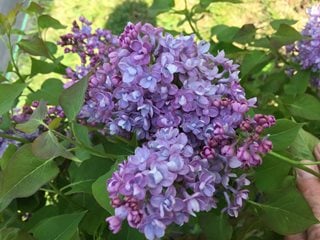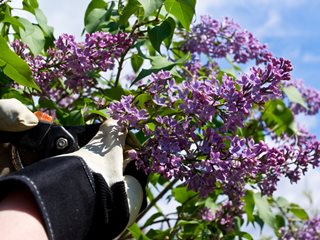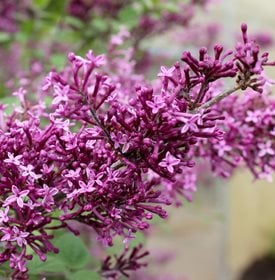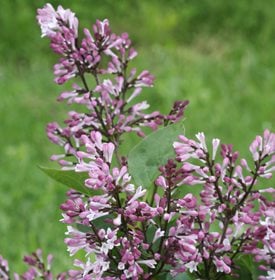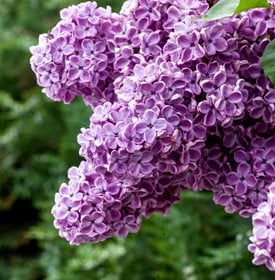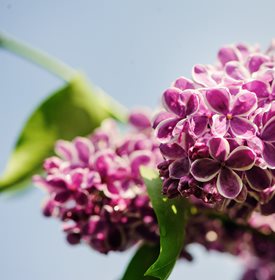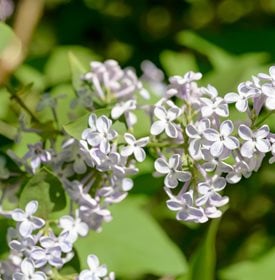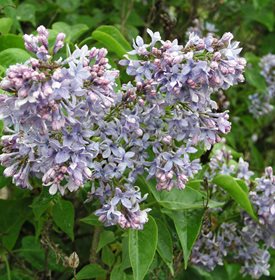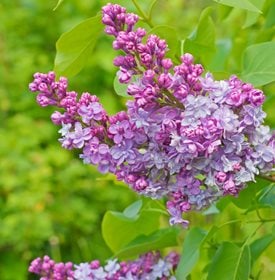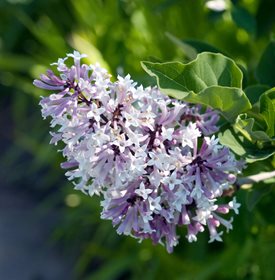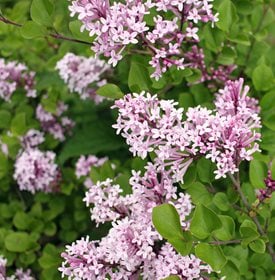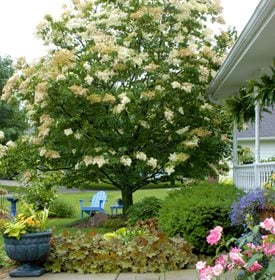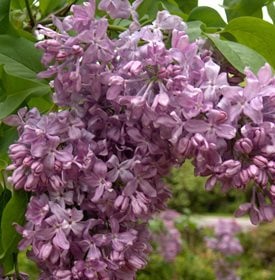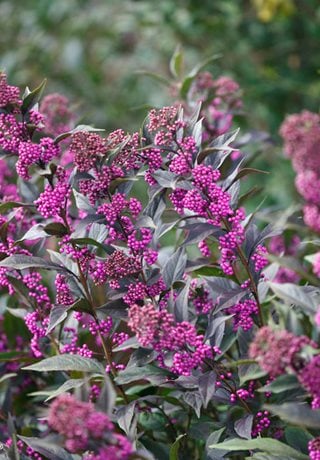Grow Lilac Bushes for Fragrant Spring Flowers
Growing tips for this intoxicating shrub with beautiful blooms Reviewed by Denise Kelly, HorticulturistUpdated 02/25/22
Lilacs are easy-to-grow, shrubs with fragrant purple flowers that bloom in spring. They attract hummingbirds, butterflies, and other pollinators and make perfect cut flowers. When properly cared for they can last decades in your garden.
2025 Flowering Shrub of the Year:
On this page: Basics | Planting | Care | Varieties | Design Ideas | Frequently Asked Questions | Lilac Festivals
On this page:
- LILAC BASICS
- PLANTING LILACS
- LILAC CARE
- LILAC VARIETIES
- LILAC DESIGN TIPS
- FREQUENTLY ASKED QUESTIONS
LILAC BASICS
Zones:
Most lilacs are hardy in zones 3-8; however, there are varieties cold hardy to zone 2, like Scentara® Double Blue (S. hyacinthiflora). There are also varieties, like 'Lavender Lady' (S. vulgaris) that are heat tolerant to zone 9 and don't require a winter chill. Most others do require a cold, dormant period over winter.
Height/Spread:
The common lilac (Syringa vulgaris) grows 12 to 15 feet tall and 10 to 12 feet wide. There are many smaller dwarf varieties that mature at 4 to 6 feet tall and 3 to 7 feet wide. Japanese tree lilacs (Syringa reticulata) can reach 25 to 30 feet tall.
Exposure:
Lilac shrubs need a minimum of 6 hours full sun for best flowering.
Bloom Time:
Most bloom in late May; however there are early spring, mid spring, and late-season blooming varieties, as well as new re-blooming varieties, like the Bloomerang® series.
Color:
The common lilac (Syringa vulgaris) has purple blossoms, dark gray-green to blue-green foliage (with no fall color change), and gray to gray-brown bark. However, there are officially 7 colors of lilac flowers: white, violet, blue, lavender, pink, magenta and purple with many shades within each color.
Other:
California lilac, mountain lilac and wild lilac aren’t true lilacs, but actually belong to the genus Ceanothus. Summer lilac is often used to refer to butterfly bushes, especially those types that are sterile and non-invasive.
PLANTING LILACS
When to plant:
Lilacs can be planted in early spring after the ground thaws or in fall before it freezes.
Where to plant:
For healthy and productive plants:
- Grow lilacs in an area with well-drained soil.
- Make sure they receive at least 6 hours of sunlight daily.
- They'll also benefit from good air circulation to help prevent powdery mildew.
- Avoid planting in an area with grass directly underneath, as the regular watering can be too much for them. Also, grass fertilizers tend to be high in nitrogen, which is bad for lilacs.
How to plant:
When planting container-grown lilacs, dig a hole twice as wide and just as deep as the container. Remove the plant from the container and place it in the hole, spreading out the roots. Back-fill with soil mixed with compost and water well. Clear a 2- to 3-foot area around the base and apply a loose layer of mulch to the area, keeping the mulch from touching the bark to prevent insect borers.
Plant spacing:
Place lilacs 5 to 15 feet apart depending on the variety.
LILAC CARE
Pruning lilacs:
Lilacs bloom on old wood and next spring’s flower buds are set almost immediately after flowering. Here are tips for pruning yours correctly:
- Prune lilacs soon after flowering. If you wait too long, you’ll be sacrificing next year’s flowers.
- Remove dead, diseased, or damaged branches to keep your shrub healthy. Improved air circulation throughout the plant will also help prevent powdery mildew.
- Spent blooms should be deadheaded.
- Root suckers on grafted lilac plants should be removed when pruning.
- Rejuvenate an older shrub with a hard pruning, even down to as low as 6 to 8 inches. Keep in mind, it may take a few years to completely grow back and blooms will be diminished in the first 2 to 3 years.
Soil:
Grow lilacs in moist, but well-drained, slightly alkaline soil.Amendments & Fertilizer:
Lilacs won’t bloom well if over-fertilized. A small amount of 10-10-10 applied in late winter is sufficient. They do like rich soil, so add compost if needed. Jerry Fritz, of Linden Hill Gardens, says that ash from the fireplace can be sprinkled on soil around the base of the shrub.
Watering:
Water regularly to establish a deep root system. It is best to water them at soil level and avoid overhead watering. Once established, lilacs are water wise. Water weekly in dry conditions, more often in extreme heat. Too little water can result in wilting or distorted leaves.
Propagation:
Seeds can be sown in spring. Seeds taken from specific cultivars may not come true from seed. In early summer, shoots from the base of the trunk can be used to propagate (not recommended for grafted varieties). Dig down at the base of the trunk and cut away the shoot, being sure to include some roots.
Diseases and Pests:
Powdery mildew on the leaves can be a frequent problem in summer and can greatly affect the foliage; however, it generally doesn’t do any permanent harm. Blights, leaf spots, and wilt can also affect lilacs, but cultivars such as the Bloomerang® series have been developed with exceptional disease resistance. Pests such as scale, borers, leaf miners, and thrips can be a nuisance as well.
VARIETIES OF LILACS
LILAC DESIGN TIPS
- Lilac bushes are an excellent choice for cottage-style gardens.
- Plant where their fragrant blooms can be enjoyed: near a pathway, main door, or window.
- Use as single specimens, in small groups, mixed in borders, or as a deciduous hedge.
- The blooms make excellent cut flowers and will last 3 to 5 days in fresh water. Cut single flowers when about one-third of the buds are open, cut double flowers when about half of the buds are open, cutting them at a slight angle.
- Some suggested companion plants: boxwood, weigela, coneflower, juniper, maiden grass, Shasta daisy, phlox, and black-eyed Susan.
FREQUENTLY ASKED QUESTIONS
Why isn't my lilac blooming?
If your lilac is getting too much water or fertilizer, or not enough sunlight, it may experience diminished flower production. Also, if it was recently hard pruned, it may take a few seasons to get back to its full glory. Also, make sure that your annual pruning is being done correctly and you aren’t cutting off the “old wood” branches that produce the flowers.
Are lilacs poisonous?
They are not toxic to humans or animals.
Are lilac roots invasive?
Their roots do need space as they will spread to about 1-1/2 times the width of the shrub, but are not considered to be invasive.
LILAC FESTIVALS
- Rochester Lilac Festival - Upstate New York
- Lilac Time - Lombard, IL
- Mackinac Island Lilac Festival - Mackinac Island, MI
- Spokane Lilac Festival - Spokane, WA
RELATED:
Flowering Shrubs
20 Fragrant Flowering Plants
15 Best Shrubs for Privacy
Hydrangea
Gardening for the Senses
